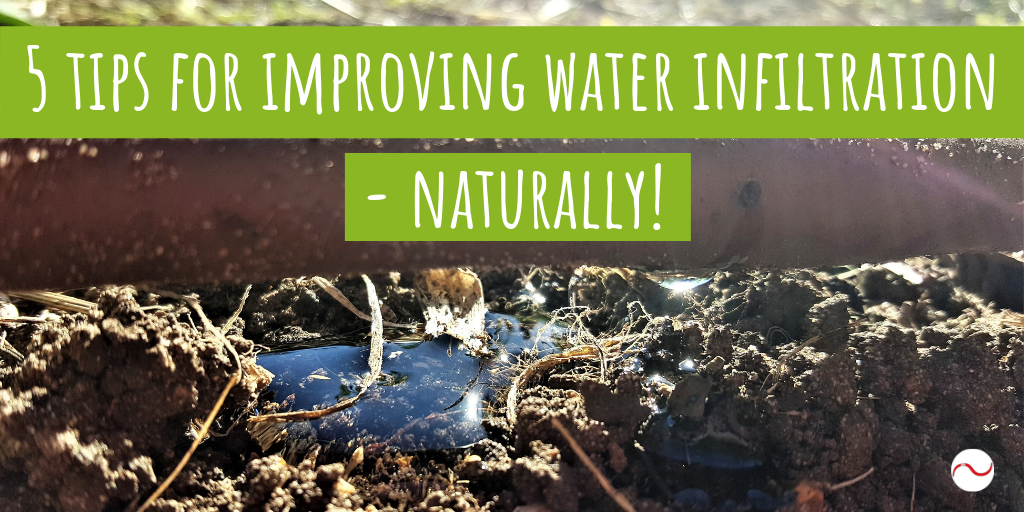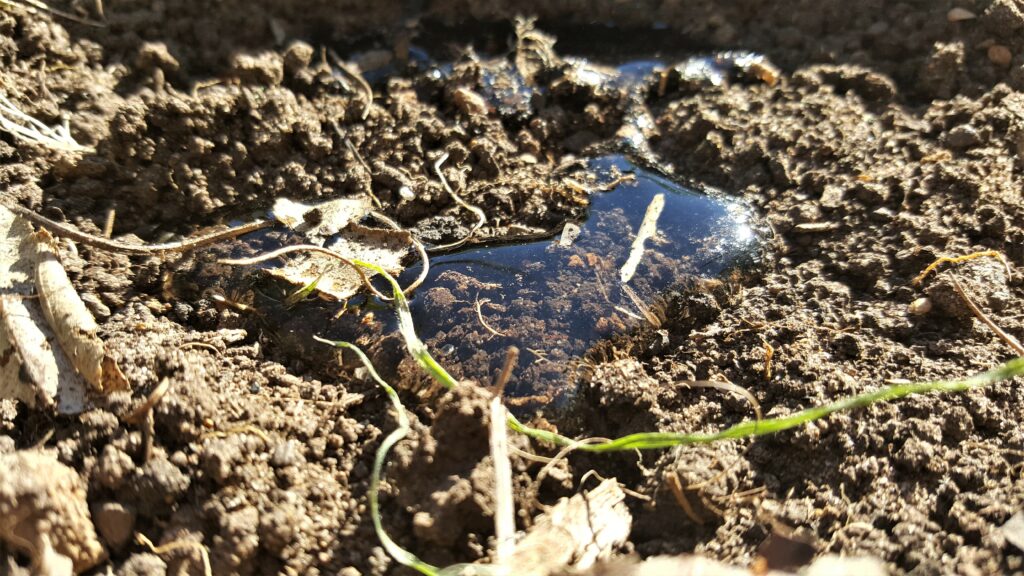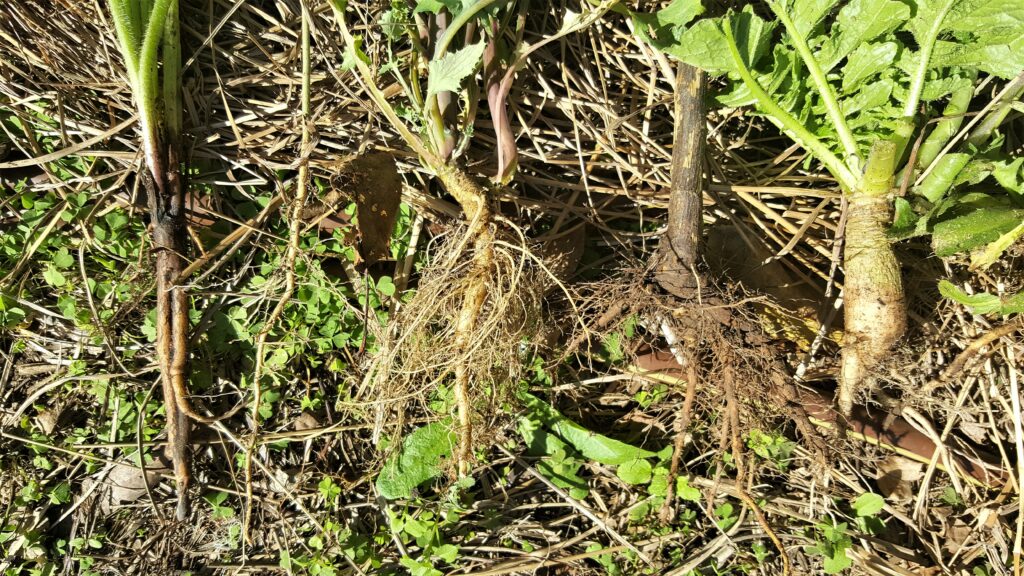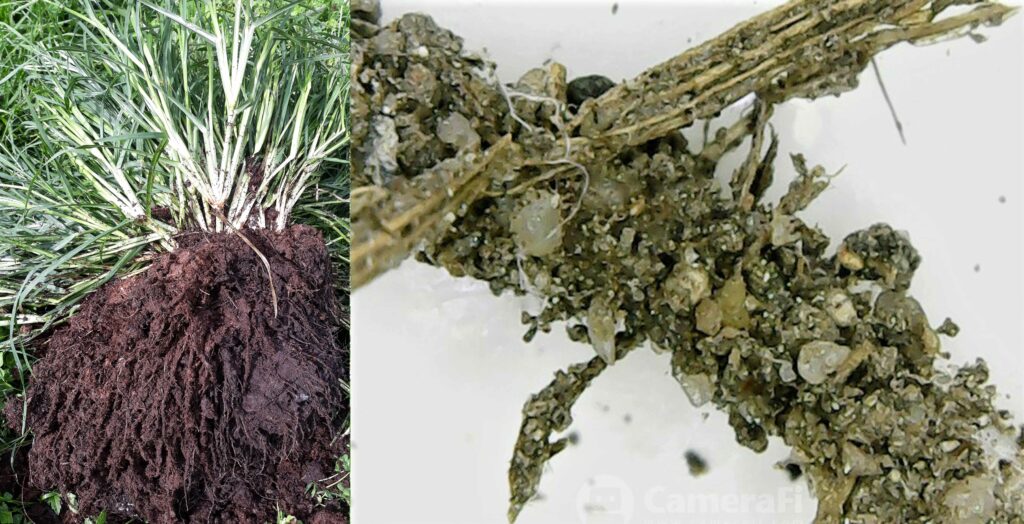
Whether your water’s coming from rain or irrigation, you want it getting where it counts – down to the root zone of your plant; and, ideally, deep into the soil to keep things ticking on later too. We don’t want to waste that light sprinkle with it all evaporating away, and we don’t want that downpour to choof off with all our topsoil into the nearest stream.
Here are five tips to help you improve water infiltration in your surface soil naturally, without the aid of synthetic wetting agents or machinery:
Tip #1: Keep your soil covered
We like to think of soil as a living organism. It needs a skin to protect it from the elements. Without any cover, soil essentially creates its own skin in the form of a waxy coating on soil particles. This acts to keep the soil microbes alive with the last vestiges of soil moisture trapped inside, but it also means that the soil surface becomes hydrophobic, or water repellent. This waxy coating can be broken down by bacteria, but the catch is that they need moisture to stay alive while they do it.
The principle of the damp sponge is also relevant here. You know when you have a sponge or dishcloth that is bone dry and you run it under the tap and all the water just beads and rolls off? But when the sponge is slightly damp it soaks up everything. This is due to the properties of water – water is attracted to itself.

The simple (though not always easy!) solution to avoid the waxy coating, help it degrade if it has formed, and keep the soil in a slightly damp state for maximum sponge action is to make sure 100% of your soil is covered by mulch or living plants. Depending on the growing situation, this might mean prioritising having groundcover over having stock, changing the way you manage stock, or looking around to see what materials are available in the quantity you need to use as mulch.
There is a recent blog post illustrating this point starkly in an agricultural context here: https://www.rcsaustralia.com.au/when-is-drought-man-made/
Tip #2: Have a diversity of plants
Specifically, allow plants with a variety of root structures to grow. Deep ones, shallow ones, thick ones, narrow ones! [Kirsty may have been reading too many children’s books.] Roots create channels in the soil called macropores. They provide a route for water to enter the soil. Tap-rooted plants can be powerful soil openers, creating a path for air and water to go deep into the soil profile. Woody plants are more likely to create macropores which stay open even after the plant has died. Grasses are excellent at feeding soil microbes, which, as you will see in tip #5, is also important for improving water infiltration. The grasses do this best when they’re in a diverse pasture. Remember: a weed is just a plant growing where you don’t want it. Perhaps this will change your perspective on which plants are weeds in your growing situation!

Tip #3: Smart fertilising
Using too much fertiliser creates a system where the soil is just a structure to hold the plant up, like hydroponics without infrastructure. Because the plant is being fed all its minerals from above, root systems are typically small and concentrated at the surface – not the deep diving masses which help water get into the soil.
Smart fertilising means only applying what the plant really needs, in a way the plant and its microbes can readily process it. A healthy soil, complete with all its microbes, will do a lot of this work for your plants without you having to worry about it. If you have the biology and your plants are showing signs of deficiency, then you can read what they’re telling you and fill the gaps. Foliar applications which incorporate fulvic acid to open the cell wall (Biocast+ has this naturally) are often the most efficient way to do this.
Tip #4: Reduce traffic when wet
Wet soil compacts more readily than dryer soil, so to keep your soil’s pores open, avoid driving on it when wet! Having plants (such as grasses) growing will give the soil more resilience to compaction.
How to tell if your soil is too wet to drive on? NSW DPI has a useful test here with other good tips too.
Tip #5: Maintain active biology
In a healthy system, plant roots have a rhizosheath made of fungi and bacteria, feeding off the root exudates to form aggregates held together by glomalin (basically fungi and bacteria spit). These rooty, soily clumps have larger pore spaces than the surrounding soil. They also act to keep the root zone wetter than the surrounding soil. The net effect is water travelling down through the soil to water the whole root zone and being absorbed a lot more easily!

In practice, you want living plants feeding the microbes, and living microbes feeding the plants. Pesticides and many synthetic fertilisers are not helpful in this endeavour. Focus on balanced nutrition, remembering all your trace minerals. Animals can be useful for adding biology through manures, bearing in mind what drenches and other medications have been used as these can have a persistent detrimental impact on microbes outside of the animal’s gut. Applying quality compost will add microbes, the ultimate in our view being fully finished worm castings. Aerobically brewed compost teas, and of course Biocast+ are really effective and efficient at adding microbes to your soil!
Bonus tip #6: Worms, worms, worms (and other critters)
If you have the tips above working for you, chances are you will also have earthworms, other burrowing insects, and even burrowing animals aerating your soils and creating conditions where water will readily soak in. Nature knows what she’s doing!
Want to see how water infiltration is going at your place? Find our instructions on how to do a simple water infiltration test here.
References:
Ahmed M. A. et al. 2014. Mucilage exudation facilitates root water uptake in dry soils. Functional Plant Biology 41(11) 1129-1137 available here
CSIRO, 2019. Water repellent soils: https://www.csiro.au/en/Research/AF/Areas/Sustainable-farming-systems/Soil-water-landscape/Water-repellent-soils
Hallett, P. D. 2008. A Brief Overview of the Causes, Impacts and Amelioration of Soil Water Repellency – a Review. Soil & Water Res., 3, 2008 (Special Issue 1): S21–S29 Available here
NSW Department of Primary Industries, 2019. Protect your soil from compaction: https://www.dpi.nsw.gov.au/agriculture/soils/structure/compaction
Shanstrom, N. 2014. Tree Roots Improve Soil Infiltration Rates. Deeproot. Available here
